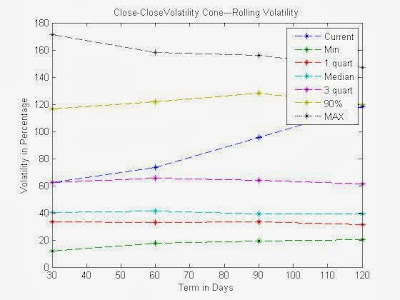
This post describes what volatility cones are and how I usually use them. As with many of my posts, I will attach code to this post.
Volatility cones are a graphical representation of realized volatility ranges over different time horizons such as 30,60,90,120 days. It gives a volatility distribution. It puts the current implied volatility into perspective. Some quotes from the book volatility trading by euan sinclair :
" The volatility cone is very useful for placing current market information (realized volatility, implied volatility and the spread between them) into historical context.We may be best served by comparing implied volatility to the historical volatility distribution given by the volatility cone. Selling one-month implied volatility at 35% because this is in the 90th percentile for one-month volatility over the past 2 years can form the basis of a sensible trading plan."
One needs to calculate the spread between 30 day rolling close to close volatility and the Implied Volatility. One needs to calculate the AVERAGE of the above spread over a sufficient time period. If the spread is Above normal then one needs to look carefully as an opportunity to trade.
As an Example, The above plot shows the Volatility cone of stock : CNH as of today 06/29/2009
The 30, 60, 90, and 120 day rolling volatilities and their percentiles are shown below and plotted above in the figure.
30 60 90 120
-----------------------------------
Current: 0.6252 0.7363 0.9564 1.1798
Min: 0.1205 0.177 0.19 0.2023
25% : 0.3324 0.3301 0.3318 0.3149
50% : 0.4039 0.4118 0.3943 0.3924
75%: 0.6239 0.6538 0.639 0.6148
90%: 1.1666 1.2162 1.2797 1.1961
MAX: 1.7115 1.5827 1.5581 1.4694
As you can see from the above table, CNH 60 day volatility has varied from a minimum of 17.7% to a maximum of 158%. The close price today is $14.32. The nearest Strike for 08/22/2009 Expiration is $15. The Implied Volatility of the call Option is 69.5 ( from Options Express website). The number of days to Expiry is 53. The Implied vol of 69.5 falls between 75% to 90% . So Approx 80% of the time in the past 4 years, the Realized Volatility of 60 days has been below that number of 69.5%. So we are in the third quartile. Whether this is high enough to sell the implied volatility or not depends on the person's risk appetite. This information gives me confidence in making the trade intelligently.
Code:
Please download all the three files into the same directory and run VolCones_CC.m
VolCones_CC.m
EstimateVol_CC.m
hist_stock_data.m
15 comments:
There is no code. Can you please post the code.
I Just Uploaded them.
thanks. very impressive. appreciate your posting these insights. you seem to be a very knowledgeable volatility trader.
do you trade options on futures? futures expire at certain times so can volatility cones be used for options on futures.
what is happening in the following line:
s = sqrt(Z)*sqrt((filter(B,A,x2) - (filter(B,A,x).^2)*(1/k))/(k-1));
This seems weird. What does the filter function do here. I would have naively just applied std matlab function to 30, 60, 90, 120 previous log returns. Why that would have been wrong?
Can you please help? I am confused
Hi,
That line avoids the need for "FOR LOOP". Effectively, what it is doing is calculating std on a rolling window basis.
Naively, it is doing:
if you have 100 data points,
for idx = 31:100
rolling30std = std(data(idx-30):data(idx))
end
So for 100 data points, it will run 70 iterations. Imagine if it is 1000 data points or greater, the "FOR Loop" will really slow down the calculations. Hence the need for faster "filter" function.
Now I have only 4 loops, each for [30,60,90,120. If we were to implement naively, It will take a lot of time for bigger matrices. try it, it will be a learning experience.
Type help filter in matlab and read the documentation. Hope it helps.
Hi, I really like your blog, and it provides lots of food for thought. I hope you can keep it up and continue this excellent blog. I've been waiting for your new post for a while:)
Execuse me,
Is the link "http://ichart.finance.yahoo.com/table.csv?s=" in line 106 of hist_stock_data.m supposed to be changed to "http://download.finance.yahoo.com/d/quotes.csv?s=" ?
Thanks for your sharing!
Hey,
Thanks for sharing, I have a similar code. i comapared and the results are inline, however, why you are not using serical correlation correction as adviced by Sinclair?
Best!!
I never heard about these codes, may be because I am just a fresher. I appreciate your efforts and it seems that you do posses a great knowledge about trading options. Thanks for sharing these line of codes.
online options trading
Wow, quite impressive, I love it. I love it so much, that the greedy visual-data gnome in me wants more!
Thanks for sharing ...
Hello guys unfortunately I ran into error. Please refer below:
>> VolCones_CC('CNH')
Reference to non-existent field 'Open'.
Error in VolCones_CC (line 4)
O = stocks.Open .* stocks.AdjClose./stocks.Close;
Could some one advice where is the problem ?
Learn Implied Volatility in Options trading. Learn Share Trading Courses, Options trading in Kolkata
Learn stock market courses. Options trading Courses for Beginners by Bikram Choudhury. Classes conducted online and also Option Trading Courses conducted in Kolkata.
Amazing Post, I Like your post if you want to aware of the stock market Get 90% accurate Share Market Tips| Indian Stock Market Tips | MCX Trading , F&O , Nifty Intraday Tips for daily Profit!!! For a Free trial give a Missed Call at 083 0211 0055.
Excellent post. I enjoy reading and also appreciate your work. This concept is a good way to enhance knowledge. Keep sharing this kind of article, Options Trading Courses Thank you.
Post a Comment